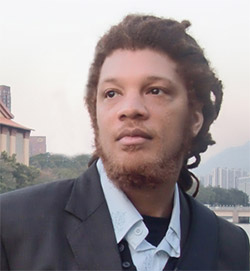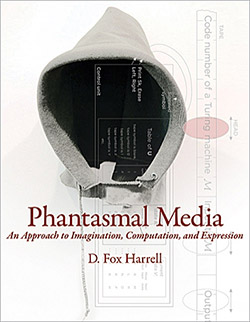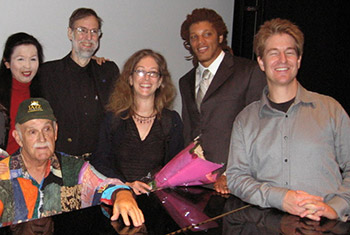
UC San Diego Alumnus Publishes Manifesto on Computing for New Forms of Cultural Expression
By:
- Doug Ramsey
Published Date
By:
- Doug Ramsey
Share This:
Article Content

D. Fox Harrell
2013 is turning out to be a banner year for University of California, San Diego alumnus D. Fox Harrell (Ph.D. Computer Science and Cognitive Science, ’07). In July he received tenure at MIT, where he is an associate professor of digital media. He juggles an appointment in Comparative Media Studies and in the Computer Science and Artificial Intelligence Laboratory (CSAIL). Now Harrell is coming to a bookstore near you with the publication this week of “Phantasmal Media: An Approach to Imagination, Computation, and Expression” (MIT Press). Carefully grounded in computer science, cognitive linguistics, and media studies, and using illustrative multicultural references ranging from classic cinema to science fiction, from Ralph Ellison to Franz Kafka, Harrell’s work has been called a manifesto on how computing can create powerful new forms of cultural expression.
The title of the book derives from Harrell’s definition of phantasms as cognitive “blends of cultural ideas and sensory imagination.” “The book provides an argument that the great expressive power of computational media arises from the construction of phantasms,” Harrell explains, “It provides an approach to analyzing how particular worldviews are built into not only computational media such as social media, e-commerce sites, and videogames, but the book provides a structured approach useful for analyzing media more generally.” Those worldviews are often antithetical to the values of society’s better self. The good news, Harrell opines, is that computing also can enable more positive creative possibilities. Just as oppressive worldviews are sometimes built into media systems, he argues, the book offers a new approach “to building systems that can instead empower users and audiences.”
Harrell credits UC San Diego’s Computer Science and Engineering (CSE) department in the Jacobs School of Engineering with helping to inform his own worldview, from the mentoring by faculty including CSE professors Victor Vianu, Geoff Voelker and the late Joseph Goguen (his advisor), while working toward his dissertation on the “Theory and Technology for Computational Narrative.” Harrell views chapter four of “Phantasmal Media” as a tribute to Goguen’s pioneering theory of algebraic semiotics, which brought him to UCSD in the first place. After Goguen’s passing, Harrell’s committee was co-chaired by Geoff Voelker and Gilles Fauconnier (UCSD Cognitive Science), and also included professors Simon Penny (UC Irvine Arts and Engineering) and Lev Manovich (formerly of UCSD Visual Arts). “I was able to lay the foundation for my current research in CSE at UCSD,” Harrell wrote to Vianu in June after receiving news he was awarded tenure at MIT, adding that he viewed the honor as “more broadly a nice endorsement of interdisciplinary possibilities in computer science.”

Book cover of “Phantasmal Media” to be published Nov. 1 by MIT Press.
Harrell now directs MIT’s Imagination, Computation and Expression (ICE) Laboratory, where he advises both Ph.D. students in Electrical Engineering and Computer Science, as well as Master’s students in Comparative Media Studies. "Humanistic research embodies an immense wisdom about subjective aspects of the human condition that designers could tap to build computational systems,” writes Harrell. “We’re at a point where it makes sense to ask humanistic questions about how the computer conveys culture."
Prior to earning his Ph.D. in 2007, Harrell designed and wrote GRIOT, a computer program, jointly with then-CSE Prof. Goguen. The name derived from a type of storyteller in many parts of the African diaspora. The program’s primary component was Alloy, a novel algorithm to generate interactive multimedia based on blending of the media. The algorithm was based on Harrell’s research in cognitive linguistics, narratology, computer science and algebraic semiotics – all of which allowed the GRIOT system to construct new metaphors in near-real time.
A performance featuring the computer program, “The Griot Sings Haibun,” premiered in October 2005 during a Computer Music Concert to mark the opening of Atkinson Hall, Calit2’s headquarters on the UC San Diego campus. The improvised performance consisted of music, poetry (spoken by CSE’s Goguen), images, and computation (with then-grad student Harrell ‘playing’ GRIOT to produce ‘polypoems’ – an interactive, multimedia and polymorphic narrative poem. The polypoems generated by the GRIOT software were haibun – a combination of narrative prose and haiku-like poetry – and they echoed the traditions of beat poetry and trans-African call-and-response. As Harrell and his colleagues pledged in posters for the performance, “Tonight our collective griot sings qualia – the qualitative feel of this human life world.” In addition to Goguen and Harrell, the Calit2 performance featured Goguen’s wife Ryoko Amadee Goguen on piano, UCSD music professor David Borgo on saxophone and flutes, and UCSD emeritus music professor Bertram Turetzky on contrabass (incidentally, Harrell’s contrabass teacher during high school). GRIOT has since been used for more sober applications, including implementing a multimedia interactive narrative memorial for the Liberian civil war called the Living Liberia Fabric.

In 2005 at Calit2, Fox Harrell with collaborator on the premiere of "The Griot Sings Haibun" for the dedication of Atkinson Hall. Back row (l-r): Ryoko Amadee Goguen, the late CSE Prof. Joseph Goguen and Harrell. Front left: UCSD Emeritus Music Prof. Bertram Turetzky. Front right: UCSD Music Prof. David Borgo.
In endorsing “Phantasmal Media,” UC Irvine professor of informatics Paul Dourish – a former member of the Calit2 divisional council at UCI – argues that the book “provides a new basis for understanding human-computer interaction and artificial intelligence.”
After earning his Ph.D. from UC San Diego in 2007, Harrell taught in the Digital Media Program in the School of Literature, Communication and Culture at the Georgia Institute of Technology, until joining MIT in 2010. In the same year, he received a five-year NSF CAREER Award to work on “computing for advanced identity representation.”
Harrell earned an M.P.S. in Interactive Telecommunications from New York University’s Tisch School of the Arts in 2000. Before that, Harrell did his undergraduate work at Carnegie Mellon University, earning a B.F.A. in Art, and B.S. in Logic and Computation, with a minor in Computer Science, Phi Beta Kappa and each with top honors.
Share This:
You May Also Like
Stay in the Know
Keep up with all the latest from UC San Diego. Subscribe to the newsletter today.


